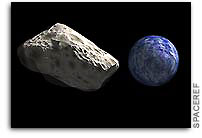Observations Result in ‘All Clear’ for Potential Asteroid Impact

University of Hawaii at Manoa astronomers made new observations of asteroid 2011 AG5 that show that this asteroid, previously thought to have a significant potential to threaten Earth, no longer poses a significant risk of impact, NASA announced today. The orbital uncertainties of the 140-meter-diameter near-Earth asteroid had previously allowed a 0.2 percent chance of collision in February 2040, leading to a call for more observations to better constrain the asteroid’s future course.
Answering the call, David Tholen, Richard Wainscoat and Marco Micheli of the UH Institute for Astronomy used the 8-meter Gemini North telescope on Mauna Kea, Hawaii, to find the small, very faint asteroid on October 20, 21 and 27, 2012.
An analysis of the new data conducted by NASA’s Near-Earth Object Program Office at the Jet Propulsion Laboratory in Pasadena, California, shows that the risk of collision in 2040 has been eliminated. The updated trajectory of 2011 AG5 is not significantly different, but the new observations have reduced the orbit uncertainties by more than a factor of 60, meaning that Earth’s position in February 2040 no longer falls within the range of possible future paths for the asteroid. With the updated orbit, the asteroid will pass no closer than 890,000 km (550,000 miles, over twice the distance to the Moon) in February 2040, the time of the prior potential collision.
This result was expected. Earlier in 2012, NASA’s NEO Program Office conducted a contingency deflection analysis for the 2040 potential impact of 2011 AG5. Among the findings was that any new observations either in 2012 or in 2013, when the object will be much easier to observe, had a 95 percent likelihood of eliminating the hazard posed by 2011 AG5. If the potential for impact had been confirmed the impact odds could have risen as high as 1 in 10, but the May 2012 study found that scenario to be unlikely. While the interest in 2011 AG5 has been reduced by the new results, the experience gained by studying this real-world deflection problem has demonstrated that NASA is well situated to detect and predict the trajectories of Earth-threatening asteroids.
In addition to the Gemini measurements, Tholen, Micheli, and Garrett Elliott obtained less conclusive observations in September and earlier in October with the UH 2.2-meter telescope, also on the summit of Mauna Kea. Tholen explained, “As it turns out, the asteroid is highly variable in brightness, which is probably why we were unable to make definitive observations on the smaller telescope.”
The data are being published by the Minor Planet Center in Cambridge, Mass.
Media Contact:
Ms. Louise Good
+1 (808) 956-9403
good@ifa.hawaii.edu
Science Contact:
David Tholen
+1 (808) 956-6930
tholen@ifa.hawaii.edu
Founded in 1967, the Institute for Astronomy at the University of Hawaii at Manoa conducts research into galaxies, cosmology, stars, planets, and the Sun. Its faculty and staff are also involved in astronomy education, deep space missions, and in the development and management of the observatories on Haleakala and Mauna Kea. The Institute operates facilities on the islands of Oahu, Maui, and Hawaii.









